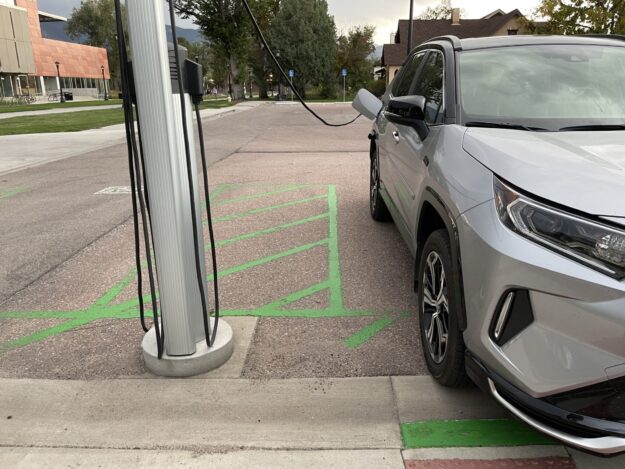Widgetized Section
Go to Admin » Appearance » Widgets » and move Gabfire Widget: Social into that MastheadOverlay zone
To EV or not to EV: That is the new car question

A full disclosure. I bought a car recently, and I had hoped it would be all electric. But I’m a tough cookie to satisfy.
Teslas are out of my price range, and Chevy Bolts looked to have long waiting lists extending into early 2023 at the earliest. My car was already gasping and wheezing by August.

Too, I don’t have a garage. Charging would have been slow with a 110-kv extension cord or charging while at the grocery store — if the charger there is working. I wasn’t reassured by what I was hearing.
Then there are what I perceive to be my needs. I wanted a car to get me to Springfield, in the state’s southeast corner, or to Cortez, and I didn’t want to have to spend days plotting out the charging infrastructure for those trips.
With all this in mind, I instead bought a used Toyota Prius.
Maybe I’ll make the plunge in 2025, even 2024, as dozens of new and somewhat lower-priced models start flooding the market.
Others were easier sells. EVs were responsible for 9.6% of all auto sales in Colorado through the first three quarters of 2022, a brisk increase from 6% for the same time frame the prior year.
Colorado is now fifth in the nation in its adoption rate.
Tax incentives may accelerate adoption. The federal government’s new Inflation Reduction Act dangles tax credits of up to $10,000, although restrictions do apply. Unabated are the Colorado state tax credits of $7,500.
Both assume higher incomes. But lawmakers in both cases hope their actions will also stimulate the adoption of EVs by lower-income people like me. But that is a more complicated story.
Travis Madsen, the transportation program manager for the Southwest Energy Efficiency Project, says he believes Colorado has already reached the level of market penetration for EVs that had previously been projected for 2025 or 2026.
“If not for the supply-chain issues we have right now, we would be going faster yet,” said Madsen. “But I expect those supply-chain issues to be resolved.”
Replacing internal combustion engines with electric vehicles has been a high priority for Colorado because transportation overtook electrical generation in 2020 as the state’s single largest source of greenhouse gas emissions. Nearly 60% of those emissions come from cars and light-duty trucks, i.e. pickups.
Too, auto exhausts have contributed greatly to the ozone and other air pollution problems that afflict the northern Front Range in particular.
To help make the case for EVs – and to provide a helping hand – the Colorado Energy Office and the Colorado Department of Transportation launched a new website called EV CO. The website points out that going electric can save owners 40% in ongoing maintenance costs and 75% in fuel costs.
See also:
Xcel Energy’s all-electric bucket truck
Bonnie Trowbridge, executive director of Drive Clean Colorado, an advocacy group that worked with the state agencies in creating the website, describes it as a “helpful tool” for accelerating the adoption of EVs.
“We want in the next year for people to feel more and more comfortable to make that leap as manufacturers begin putting more new models for sale and more used EVs start arriving into the marketplace.”
The accumulating evidence suggests that Colorado’s goal of having 940,000 vehicles on the road by 2030 is realistic, she says. The state already has nearly 68,000 EVs on its roads.
Charging infrastructure underlies this transformation. Most charging will occur at home, but when we do travel, we want some assurances, right?
While Colorado has been adding stations at a rapid clip, it still has a way to go. The fast-charging stations are certainly not as ubiquitous as gasoline stations, and the current technology does not yet offer the same ease of use as liquid fuels. You need to plot your trips carefully.
And how good will the infrastructure be once you get there? That is one of the doubts that kept me from making the $30,000 plunge for a Chevy Bolt. I see charging stations all around at gas grocery stories and what not. But are they maintained?
For example, I can drive to southeast Colorado, where the Springfield Police Department has a charging station for public use. But I also see notes that the charging station has not been operated reliably. “A complete bust,” wrote one frustrated would-be EV charger in April 2022. “Avoid.” Another posting from January 2022 told of having to get towed 50 miles (to Lamar) because of an inability to get charged up in Springfield.
I presume this will get better as the market demand rises and more money gets poured into charging infrastructure. The energy office’s Carrie Atiyeh points out that the state plans to spend $25 million next year for charging infrastructure.
This story was published in Big Pivots 63 (Nov. 30, 2022). Please consider subscribing.
Colorado’s planning, done in tandem with other states, called for fast-charging stations on the state’s major arteries, with a goal of having those stations every 50 miles or less. It will include the interstates, of course, and the state’s other east-west corridors.
At the opposite end of the spectrum, Colorado also has set out to make its investor-owned utilities partners in creating the charging infrastructure. The intent is to provide charging infrastructure altogether —but with a special concern about making it possible for people in apartment houses and other multi-family living arrangements that may lack garages to charge. The intermediary for this planning has been the Public Utilities Commission, or PUC.
SWEEP’s Madsen points out that Xcel has had two years to work on these programs. The utility didn’t get everything right the first time, especially in the application of programs intended to help lower-income individuals have access to charging infrastructure. But they’re tinkering.
“I think Xcel has increased the incentives to do charging installations in low-income housing because the original incentives weren’t enough,” he says. Utilities across Colorado are learning from each other about how to get it right.
Meanwhile, dozens of new all-electric models with a variety of price points are planned for entry into the U.S. market by 2024, Consumer Reports pointed out in a September article.
“These more affordable models have the potential to sway a significant percentage of the car-buying public toward buying an EV with their efficiency, performance, and lower ownership costs,” says Gabe Shenhar, associate director of Consumer Reports’ Auto Test Center.
General Motors this past week announced it expects to stop hemorrhaging money on its electric manufacturing assembly lines and begin to make profits by 2025 comparable to those of its gasoline-powered vehicles. This is years ahead of original projections for profitability.
Helping drive demand will be the sack of carrots delivered by the federal government’s inflation. The effect of the tax incentives will be muddled in the short term, however, by the application limited to those models with battery components sourced from within North America.
Princeton University’s Jesse Jenkins told Ezra Klein of the New York Times in September that this will limit the impact of the federal tax incentives in the short term.
In the near term, said Jenkins, the law won’t greatly affect the total volume of EVs sold in the next couple of years “because we are still scaling up that supply chain and demand already outstrips supply.”
Auto-makers are pouring investment of what will end up being a trillion dollars into manufacturing capacity during the coming decade, says Jenkins.
Editor’s note: This column first appeared on Allen Best’s Big Pivots e-magazine. Best is a former Vail-area resident and longtime journalist based on Colorado’s Front Range. Reach him at allen.best@comcast.net or 720.415.9308.
Latest posts by Allen Best, Big Pivots (see all)
- Analysis: Colorado data center bill raises serious questions of electric consumers subsidizing Big Tech - April 15, 2025
- Hurd, Evans walking fine line on renewable energy as Trump pushes ‘drill, baby, drill’ oil, gas agenda - March 21, 2025
- Big Pivots: Holy Cross Energy takes another step toward 100% renewable energy - December 17, 2024



Michael Sanner
December 6, 2022 at 12:14 pm
A good way to compare the cost of an EV with a gas car is to look at Total Cost of Ownership, usually using a 5 year period. Since maintenance costs and fuel costs are much lower, as pointed out in your article, the total cost of ownership over 5 years ends up be about the same for a $25,000 gas car as a $50,000 EV! The variables are cost of gas and cost of electricity. But generally, this is about right. The other factor, rarely mentioned, is that a gas car as it gets older tends to have more maintenance issues that get costlier with time. The EV tends to not have these issues due to its simplicity. It has only a few parts, and the motors are usually good for about 500,000 miles!
I have owned a Tesla for over 4 years and have had no maintenance, other than buying tires. Even my fuel, electricity, is free as it comes from my solar panels.
Unlike other EVs, Tesla, has the best charging network hands down. It tells you where they are as you travel and when and where to stop to reach your destination. It is totally awesome and requires no preplanning as the network of super-chargers are so extensive. Other EVs do not have their own charging networks and rely on unreliable 3-rd party chargers, which can be broken or not maintained.
Bottom line, if you are to buy an EV, one should get a Tesla if one wants to travel beyond daily commutes. This is due to the quality of the car with its superior range and the superior charging network. Tesla has offered to open up their charging network to other car companies but they seem unwilling to take Tesla up on this offer. Head scratching?